Best Tips to Save Money on Farm Inputs in 2022
May 9, 2022

Farmers always keep an eye on their bottom line. But recent inflationary pressures, increasing commodity prices, economic instability, and even global supply chain issues are making this an even bigger priority in 2022. One of the ways to save money in an operation is by getting a handle on your farm inputs.
Fortunately, saving money on inputs does not require a secret, magic formula. It’s a combination of practicality, common sense, and a willingness to use the tools and technology available to you.
Here are some great ways to save money on farm inputs this year:
Implement efficient purchasing strategies
Lowering the actual cost of these inputs is an easy way to increase profitability. The key is to have a sustainable purchasing strategy in place. Knowing the cost of your seed, fertilizer, herbicides, and other farm inputs is the first step, which allows you to track cost trends and maximize the timing of your purchases. Some suppliers and vendors will offer discounts and financing terms based on the volume purchased as well as the timing — savings can often be found by buying product well in advance of the upcoming season.
While it looks like the global pandemic may finally be winding down, it has undoubtedly changed the way suppliers are conducting business in our industry. After two years of social distancing, periodic closures, and navigating the “new normal” of doing business, many suppliers have turned to the digital side to communicate with producers. And that’s a good thing: more information is now available online 24/7 to help you with important decisions. Some suppliers have even gone to online ordering rather than phone calls or in-person. Regardless of your digital comfort level, more information and services are now accessible from the convenience of your office chair.
Use prescription maps to understand your input needs
VRA solutions such are prescription maps are a great way to use the information you have – or can get – about your fields. Historic yields, soil nutrient levels, and GPS information can be compiled to create specific zones, and input concentration can be adjusted as you move through those zones. Prescription maps help operators avoid overapplication and underapplication of inputs, allowing you to hit that sweet spot in between where your crops will thrive. The great thing about this is that Trimble’s precision agriculture approaches give you the means to use this information through Variable Rate Technology (VRT).
VRT means that your farm field technology uses this information to provide Variable Rate Application (VRA) in your fields. Trimble’s precision farming technology offers a means to use this information throughout the entire growing season, from planting and seeding to spraying and spreading.
Incorporate VRT and VRA into your operation
Having that information is one thing, but appropriately using it through VRT is where the real cost savings can happen. Trimble has you covered: Trimble’s Field-IQ Crop Input Control System allows you to control spraying, spreading, seeding, and planting by tailoring your implement and field applications based on this information. This happens in real time, providing increased precision for your VRA.
Most operations employ a variety of implements, and that may span a few manufacturers. Trimble’s VRA systems use a variety of communication protocols such as ISOBUS, the international standard that allows your equipment to communicate with each other regardless of the brands. ISOBUS technology acts as a universal language between implements and controls, which will enable you to use the hardware you already own to implement VRT and VRA.
To discover how precision ag solutions can help you save on farm inputs this year, contact your local Trimble Reseller today.
Tags: cost savings, Farm savings, flow and application, Input Management, ISOBUS, Trimble Ag, variable rate application, variable rate technology, vra, VRT